As the 2017 Trade Period draws to a close, Sydney Swans historian/contributor Peter Blucher take a closer look at how the Sydney Swans have fared in silly seasons gone by.
All-in-all, a total of 51 players have been traded into the football club.
Blucher places 14 of those in the the "Swans Super-Trade Club" given their achievements on-field which include premierships, club championships, All-Australian honours and Coleman medals.
Part 1 of this three-part feature, touches on the super trades and those unlucky not to make the grade.
Part 2 hones in on Tony Lockett, Josh Kennedy, Barry Hall, Ted Richards, Rhyce Shaw, Jason Ball and Paul Williams.
Part 3 hones in on Darren Jolly, Shane Mumford, Nick Davis, Wayne Schwass, Martin Mattner and Mitch Morton.
...
A surprise packet.
Andrew Schauble didn’t exactly set the world on fire in his five years at Collingwood from 1995-99. Originally drafted with selection #66 in 1993, he played 79 games for 27 wins and twice finished top 10 on the club championship – equal eighth in 1996 and sixth in 1998.
Going on 23, a product of Xavier College in Melbourne, he was a promising type but no world beater.
Yet 12 months later in 2000, he had joined the Sydney Swans Super Trade Club.
In his first season in Sydney Schauble played every game in a Swans side that finished 10th with a 10-12 win/loss record, and surprised everyone when he won the Bob Skilton Medal.
The voting leaderboard had Schauble at the top with 154 votes from Michael O’Loughlin (150), Daryn Cresswell (141), Wayne Schwass (122), Greg Stafford (103), Ben Mathews (97), Jared Crouch (86), Jason Saddington (76), Stuart Maxfield (69) and Andrew Dunkley (68).
The Schauble player profile in the 2001 AFL Guide wrote of his performance: “Exceeded all expectations in his first year with the Swans, quickly settling in at centre half back and having such a good year that he took out the best and fairest. Benefitted from being in a stronger defensive line-up, regaining confidence in flying for his marks and showing readiness to run off his opponent. Prepares himself sensationally and has a very down-to-earth approach to the game. Defeated the best forwards in the game and shapes as a senior leader”.
It was all a by-product of an excellent trade in the 1999 Draft in which Sydney secured Schauble from Collingwood in exchange for selection #34 and young defender Mark Kinnear, who had played six games for the Swans in 1997-98 after being taken at #4 in 1996.
Although Kinnear never played a senior game for Collingwood and retired at the end of 1999 the Magpies did use selection #34 to grab Leon Davis, who played 225 games, was twice All-Australian, and collected a 2010 premiership medal after playing in the drawn grand final against St.Kilda before being dropped for the replay.
It didn’t matter to Sydney – they had their man. Schauble went on to play 88 games for the club, including four finals. But for injuries which restricted him to four games in 2005 he may have been a premiership player. He retired during to ongoing injury problems at 28.
The man with the golden touch.
There are no big individual awards or special representative honours in the career highlights section of Darren Jolly’s biography. In fact there are only two short lines. But he will tell you they are all that matter. Sydney premiership player 2005. Collingwood premiership player 2010.
Jolly, a 237-game AFL veteran with three clubs, was like the AFL trade property with the golden touch. He won won a flag in his first season with the Swans after being traded from Melbourne, and did likewise at the Magpies after being traded from Sydney.
The Swans had targeted Jolly at the end of the 2004 season to support aging veteran Jason Ball, who would be 32 heading into the ’05 season after he’d shared the ’04 ruck duties with Stephen Doyle, who had played a career-high 19 games in 2004 but was destined not quite to hit the heights he may have wished.
Jolly, originally a product of the rookie draft from North Ballarat, had played only 48 games in four years at Melbourne, mainly as a back-up to former #1 draft pick Jeff White.
But the Swans brainstrust decided he was their man. So, they aggressively chased the then 23-year-old. They secured his services in exchange for selection #15 in the National Draft, which Melbourne subsequently used to draft key defender Lyndon Dunn, who went on to play 165 games for the Demons over 12 years before a 2017 switch to Collingwood.
While Dunn ultimately gave good service to Melbourne, there was no doubting 12 months later who had got the better of the Jolly trade.
While Dunn spent the entire 2005 season with Melbourne’s VFL affiliate team Sandringham, Jolly played 24 of a possible 26 games, including four finals, and ranked fourth in the League for hit-outs behind West Coast’s Dean Cox, Hawthorn’s Peter Everitt and Melbourne’s White.
The only two games Jolly missed that season and throughout his entire time at Sydney were through a two-week suspension incurred an incident against his form club.
In the grand final win over West Coast he had 10 possessions, 12 hit-outs, a goal and a goal assist as the Swans won by five points.
Jolly went on to play 118 games for the Swans in five years, including the losing 2006 grand final against West Coast, when his wife Deanne gave birth to the couple’s first child the day before the game.
The timing was impeccable and imperative after Jolly had told coach Paul Roos he would not play if his wife was to give birth on the day of the grand final.
Jolly finished ninth in the Swans club championship in 2007, eighth in 2008 and fourth in 2009, but at the end of the ’09 campaign he asked to be traded to a Melbourne-based club for family reasons.
After widespread interest Sydney, content that at 28 Jolly had done what he had been recruited to do, sent him to Collingwood in exchange for picks 14 and 46 in what would be a busy and very productive 2009 Draft.
With selection #14 the Swans secured 2012 premiership player Lewis Jetta, while they bundled #46 up into a package which secured Josh Kennedy and Ben McGlynn from Hawthorn after they had earlier traded selection #22 to West Coast for Mark Seaby.
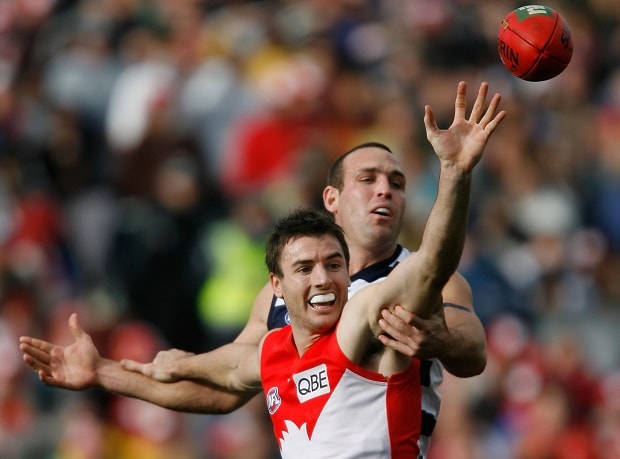
Jolly's partnership with Jason Ball was crucial to the Swans' success in 2005.
Third-stringer turned premiership ruckman.
It is one of the real oddities of AFL football that in 2009 Shane Mumford could not get a game in the Geelong grand final side, but in 2010 he earned more than half the Cats’ premiership side, and in 2012 was a Sydney Swans premiership player.
How? It a was mixture of a lot of things, but critical to the whole story was some very astute and aggressive recruiting and trading work by the Swans.
Mumford was a young giant from Bunyip in Gippsland who had slipped through the traditional AFL drafting net, and at 20 in 2006, weighing 120kg, he won the Bunyip best & fairest award, and was runner-up in the Ellinbank and District League medal.
It was enough for Geelong to target him for their 2007 VFL side. And although he played only six VFL games for the Cats, and was dropped for the grand final to make way for Steven King’s return from injury, the ruck work of a significantly and lighter Mumford saw him taken by Geelong with their last pic in the 2008 Rookie Draft.
He played three games with the Cats in 2008 as an injury replacement, and 18 games in a row from Rounds 4-21 in 2009. But in Round 22 Mumford was dropped to make way for the return of Brad Ottens, who had missed 20 weeks with a knee injury. And from then on Ottens and Mark Blake shared the ruck duties in a side that beat St.Kilda in the grand final.
Shattered at the time, Mumford quickly took consolation in a lucrative offer from the Swans after having impressed coach Paul Roos in two matches against them that season.
When first-string Sydney ruckman Darren Jolly sought a trade to a Melbourne-based club for family reasons the Swans targeted the big Cat.
Despite some early reservations and an impassioned late plea from Geelong coach Mark Thompson the Swans got their man with what was reportedly a four-year deal worth up to $1.2million.
Geelong were said to be ‘filthy’, but in the end they traded Mumford to Sydney for selection #28 in the 2009 National Draft after it became obvious he could easily have put himself into the pre-season draft and got to Sydney for nothing.
The Swans already had an experienced ruckman in ex-West Coast Eagle Mark Seaby and a promising Canadian rugby convert in Mike Pyke, but Mumford quickly established himself as the club’s No.1 ruckman.
He finished runner-up to Kieren Jack in the club championship in his first season in Sydney in 2010, when he was also named in the 44-man All-Australian squad, and was eighth in the club championship in 2011.
But it was in 2012 that the Swans really got their reward for the Mumford trade. Despite playing only two of the first nine games due to back troubles he filled a key role in the club’s charge to the grand final, when they beat Hawthorn by 10 points.
He went on to play 79 games for the Swans over four years but when the club needed to create salary cap room in 2014 following the prized capture of Lance Franklin Mumford was traded to the GWS Giants for selection #39 in the 2013 National Draft. He played 72 games for the Giants in four years before his injury-forced retirement at the end of 2017.
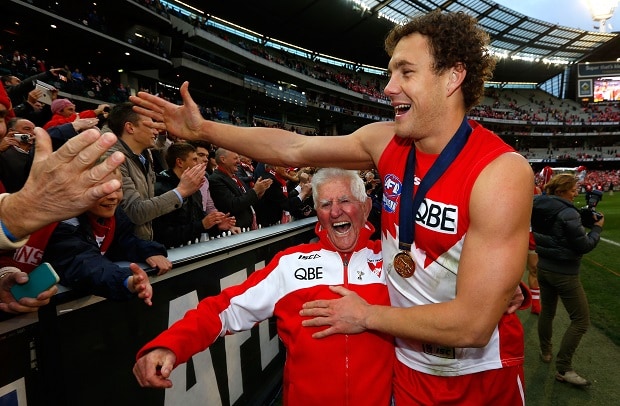
Mumford, with Kenny by his side, thanks the crowd during the 2012 premiership celebrations.
Fifteen-minute payback.
If it is possible to repay a six-year trade investment in 15 minutes Nick Davis did exactly that in 2005.
With the Swans 23 points down mid-way through the final term of in a low-scoring semi-final against Geelong at the SCG Davis turned a regulation trade into a masterstroke.
He kicked four goals in a blitz which coach Paul Roos at the time rated the best quarter of finals football ever played, and which was so special it was subsequently added to the Swans Heritage List.
Two weeks later, after Davis had single-handedly rescued a premiership campaign which looked bound for disappointment, the Swans beat West Coast in the grand final to claim their first flag since 1933.
Davis, playing his 57th game for Sydney when he etched his name into club history, went on to play 97 games for the club over six years and kick 150 goals.
Only 38 players in history have klcked more goals than Davis, and of those 38 only five did so in fewer games – Warwick Capper, Lance Franklin, John Sudholz, Simon Minton-Connell and Stewart Gull.
In retirement, too, Davis has been a valuable asset, becoming a well-respected and popular asset in coaching and development.
But for everything else he did and continues to do, his 15 minutes of magic in the 2005 semi-final more than justified the club’s decision to take him in exchange for selection 21 in the 2002 National Draft.
This was the pick the Collingwood used to draft Bo Nixon, a 191cm forward who played three games for the Magpies in 2004 and one game for Hawthorn in 2005.
Davis, son of 163-game Carlton, North Melbourne, Collingwood and Sydney forward Craig Davis, was always destined to be a Swans player. But it was a journey which took its time.
Born in Melbourne, he moved to Sydney with the family aged four. After initially playing rugby league he switched to AFL and joined Collingwood as a father/son selection in the 1998 Draft.
He debuted in 1999 as an 18-year-old and played 16 games in his first season in but he was never comfortable in the spotlight at Collingwood and after 71 games in four years he sought and was granted a passage back to Sydney.
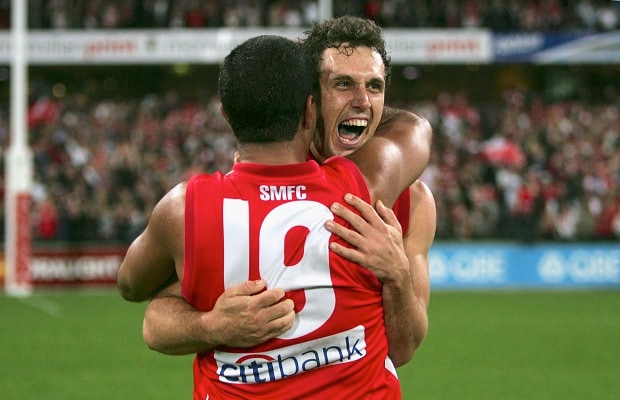
Michael O'Loughlin celebrates with Davis after his match-winning four goals in the 2005 semi-final.
A win-win trade.
When Wayne Schwass walked off the MCG with North Melbourne for the last time in 1997 after a preliminary final loss to St.Kilda it was clear all was not well. Schwass and Glenn Archer had missed the game through suspension and were targeted by a fearsome glare and a very public verbal spray from coach Dennis Pagan.
Despite 184 games, two club championships and a coveted premiership medal in 10 years with North 28-year-old Schwass decided he needed a fresh start. He wanted out.
About the same time in Sydney 20-year-old Shannon Grant was weighing up his future with the Swans. Drafted with selection #3 in 1994, he’d played 58 games in the red and white and was set for a long and fruitful career but had been stung by the go-home bug.
So, common sense prevailed. The players swapped clubs in a deal which, despite the age disparity, became one of the genuine win/win trades.
Schwass certainly earned his place in the Swans Super Trade Club. He played 98 games for the Swans from 1998-2002, and in 1999 won the Bob Skilton Medal and an All-Australian jumper.
In four completed seasons wearing the #2 jumper before an injury-driven retirement in mid-2002 the experienced and inspirational midfielder finished 4th-1st-4th-6th in the club championship. He was a star.
That Grant was similarly successful at North was irrelevant. It was a price the club was more than happy to secure a player of Schwass’s calibre. A genuine win/win trade.
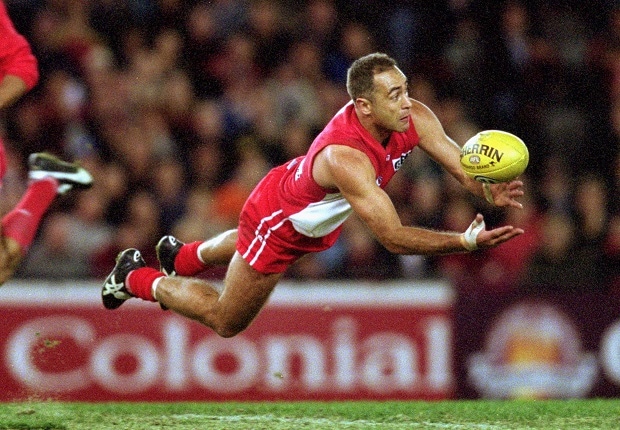
Schwass became a great servant of the Club over 98 games.
Confidence the key.
Confidence is such a critical element of a good AFL footballer’s make it. The Sydney Swans gave it to Martin Mattner in big doses and were rewarded with a 100-game premiership player
Mattner had played 98 games for Adelaide from 2002-07 after coming off the rookie list. He’d finished eighth in the club’s best and fairest award in 2005 and polled 20 votes in the Brownlow Medal in 2005-06, when the Crows played in the preliminary final each year.
He polled nine Brownlow votes in 2005 to rank fourth among Crows players, and 11 votes in 2006 when he ranked second. Over the two years only 300-gamer Tyson Edwards polled more votes for the club.
But 12 months later, when Mattner had been left out of the club’s losing elimination final side after he’d played 19 home-and-away games, he was offered just a one-year contract extension.
It was the opening the Swans wanted. Although Mattner had accepted the one-year deal he was tempted by a three-year offer by Sydney. And after the customary trade interaction between the parties he moved to the Harbour City for selection #28 in the 2007 AFL National Draft.
It the pick was ultimately traded to Port Adelaide for Brad Symes, a 20-game Power player turned 60-game Crow, and saw the Power pick up Marlon Motlop, who played five games for the Power.
No doubt the Swans won on the deal as Mattner went on to play 124 games in red and white, including nine finals and the 2012 premiership in which he will long be remembered for a crucial run-down tackle on Grant Birchall in the closing minutes of a 10-point win over Hawthorn.
Twelve months after he was effectively shown the door by the Crows he finished third in the 2008 Bob Skilton Medal behind Jarrad McVeigh and Brett Kirk.
He was also eighth in the Skilton Medal in 2009, and in his first five years in Sydney from 2008-12 he played 117 of a possible 119 games. He played the first seven games of 2013 before a serious and potentially debilitating hip problem forced his immediate retirement.
At the time of his retirement 222-game Mattner told how Sydney’s show of faith in him via a long-term contract was the thing that drove him to the club, and made his career.
"It was the best decision for my football. Sydney showed confidence in me by giving me a simple role - they let me play to my strength.
"At Sydney, I was a defender who was to run and create rebound from the half-back flank. First, I had to defend by beating my opponent. It was basic, honest footy. Sydney simplified it for me.”
Sixth on the Swans’ list of games played by trade-in players behind Ted Richards (228), Josh Kennedy (191), Barry Hall (162), Rhyce Shaw (143) and Ben McGlynn (127), Mattner later coached Sturt to the 2016-17 SANFL premierships in his first two years in the job.
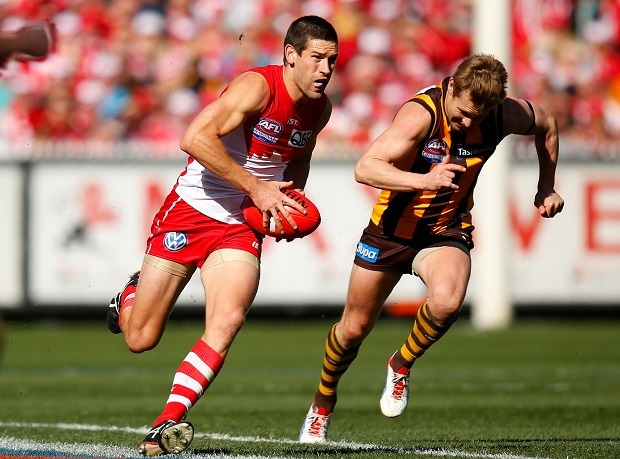
Mattner bursts away from Hawthorn's Sam Mitchell in the 2012 Grand Final.
A virtual free trade.
It wouldn’t be unreasonable to assume that you’re not going to get much out of a trade when the other party doesn’t even bother to use their part of the deal. Especially when the player who is traded in plays only 12 games for his new club.
But in the case of Mitch Morton that would be entirely wrong. On both fronts.
Morton, a 186cm utility originally drafted by West Coast under the WA father/son rules, had played 12 games for West Coast from 2005-07 and 59 games for Richmond from 2008-11.
Ironically, he was traded from West Coast to Richmond in exchange for selection #38 in the 2007 National Draft which finished up at Sydney and was used by the club to draft Sam Reid.
Morton moved to the SCG prior to the 2011 National Draft in exchange for a fourth-round draft selection which the Tigers didn’t even use. Effectively, he was tossed aside.
The Swans gave him a chance. And although he played only 12 games and kicked 10 goals in red and white he is a member of an exclusive Swans club. The premiership club.
In one of the great Swans fairytales, Morton played in the winning 2012 grand final side against Hawthorn in just his fifth game for the club.
In a low-scoring game in which he played 60% of game time he had 11 disposals and four tackles, and kicked two crucial goals late in the second quarter which turned a four-point Sydney lead into a 16-point advantage at halftime.
Among 93 premiership players in South Melbourne Sydney Swans history, none have had a shorter wait in the red and white jumper to savour the ultimate football triumph.
The next quickest journey to a flag is Dinny Kelleher’s seven games in 1933, when South Melbourne beat Richmond by 42 points in the grand final in front of the League’s first crowd of more than 75,000.
The ex-Wangaratta ruckman had played 54 games with Carlton from 1927-32 before joining South and played Rounds 10-11-16-17-18 plus the semi-final and grand final in 1933. He went on to play 59 games for the Swans.
Dave Barry played in the 1909 South Melbourne premiership in just his 10th game. A half forward flanker originally from Leopold in Geelong, he debuted in Round 2 that year aged 20, played eight games straight, missed the next nine, and returned for the preliminary final and grand final.
Barry played a further 14 games in 1910, including a losing preliminary final, before moving to Western Australia. He was killed when hit by a train in a railway crossing accident in 1913 aged 24.
Jock McKenzie also waited just 10 games before a flag with South Melbourne in 1933. A back pocket player with the club, he debuted as a 19-year-old in 1931, but had to wait more than two years for his second game, but after breaking into the side in Round 12 he held his spot right through to the grand final.
McKenzie later played in South Melbourne’s losing grand final sides in 1934 and 1935, and after 44 games with the club switched to Fitzroy in 1936. He played 48 games in four years with the Lions, mainly as a forward, and returned to South for a further 11 games in 1940.
Morton began the 2012 season as a Swans emergency in Round 1 and then played 16 games in a row in the NEAFL. He was an emergency again in Round 19, played Round 20 in the NEAFL, and made his Swans debut in Round 21 against the Western Bulldogs at Docklands.
The Swans won by 82 points after being 18 points down at quarter-time. Shane Mumford and Mike Pyke each kicked a career-best three goals, Lewis Roberts-Thomson was one off his best with three goals, and Morton had four disposals and kicked a goal.
Morton held his spot for the seven-point loss to Hawthorn in Round 22, when he had five disposals, but was replaced by Armstrong for the final round of the home-and-away season against Geelong, when the Swans were beaten by 34 points.
Armstrong had 21 disposals against the Cats, but was dropped to make way for Morton in the for qualifying final against Adelaide. And that’s the way it stayed. Morton played against Adelaide, Collingwood in the preliminary final, and Hawthorn in the grand final. Armstrong was an emergency for all three.
When he walked off the MCG on 29 December 2012 with a premiership around his neck Morton had played all of about 292 minutes in the #10 Swans jumper for a total of 42 disposals, five goals and 15 tackles.
Having never played a final in seven years at West Coast and Richmond he’d played three in five weeks with the Swans. Or more precisely, 22 days.
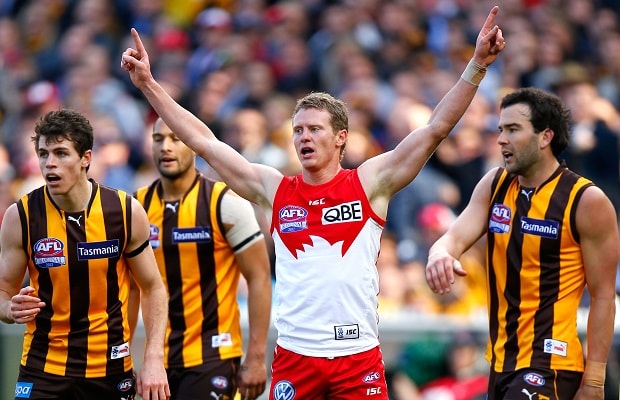
Morton celebrates one of his two goals in the 2012 Grand Final.


